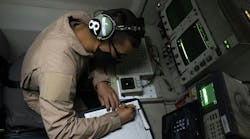By John McHale
ROSELAND, N.J.—Officials at Curtiss-Wright Corp., the parent of embedded electronics supplier Curtiss-Wright Controls Embedded Computing (CWCEC) in Leesburg, Va., are proposing to acquire VMETRO in Houston, Texas, for about $54 million.
VMETRO executives say they find the Curtiss-Wright acquisition proposal acceptable, unless they object to anything in final negotiations. The acquisition would make the CWCEC division even more of a giant in the defense embedded electronics market.
Including VMETRO, CWCEC has added eight companies to its portfolio since the beginning of the decade. They include: Vista Controls in 2001; Peritek in 2003; Systran in 2003; Dy 4 Systems, Primagraphics, and Synergy Microsystems in 2004; and Pentland Systems in 2008.
The move by Curtiss-Wright shows how successful VMETRO’s commercial off-the-shelf (COTS) products have been in the defense market, says Christian Jebsen, president and chief executive officer of VMETRO, which had received other inquiries. VMETRO’s board of directors found the Curtiss-Wright offer acceptable immediately as did a majority of shareholders, he adds.
VMETRO finished with revenues of about $57 million last year and expects even greater growth this year, now that Micro Memory—a company VMETRO acquired last year—will be on the books for a whole year, Jebsen adds. VMETRO’s strong financial numbers, reputation for technological expertise, and its market strength in Europe help make it attractive to companies such as Curtiss-Wright, he adds.
VMETRO’s global headquarters is based in Oslo, Norway, and sells to the European market under the name VSYSTEMS. The company also has a division in Trondheim, Norway, called 3D Radar, which develops ground-penetrating radar systems.
Micro Memory, which is based in Chatsworth, Calif., provides board-level products for streaming signal and image processing, real-time data acquisition, memory nodes, and enterprise network storage.
Curtiss-Wright’s net earnings for the first six months of 2008 were $48.9 million, an increase of 19 percent over the first six months of 2007.
A Curtiss-Wright spokesman says that including the CWCEC acquisitions, Curtiss-Wright as a whole made more than 40 acquisitions since 2000, totaling more than $1 billion in investments. He declined to elaborate further.
VMETRO makes a strong addition to the CWCEC portfolio by providing COTS board- and system-level embedded computer products for military, aerospace, industrial, communications, medical, enterprise computing, and network storage. The company also specializes in high-speed serial interconnects like PCI Express, Serial RapidIO, Aurora, and Serial FPDP, based on standard formats like VXS, VPX, VME, PMC, XMC, FMC, PCI/PCI-X, PCI Express, AdvancedMC, and CompactPCI.
VMETRO, with its roots in Norway, also promises to enhance the availability of Curtiss-Wright’s embedded computing products in Europe and in other regions of the international market.
Curtiss-Wright, which was founded as an aircraft manufacturer a century ago by Glenn Curtiss and Wilbur and Orville Wright, now through its CWCEC arm provides embedded solutions ranging from board-level products to integrated subsystems. Its product expertise includes radar and graphics solutions, high-speed communications, custom software design and hardware engineering, and manufacturing services. Also, like VMETRO, Curtiss-Wright specializes in high-speed serial interconnects and products based on standard formats like VME and CompactPCI.
CWCEC was not alone in its shopping spree during that period. Another embedded supplier, GE Fanuc Intelligent Platforms in Charlottesville, Va., used an aggressive acquisition strategy to become every bit as gigantic as CWCEC in the embedded world—adding embedded providers, such as Radstone Technology and SBS Technologies.
Some industry analysts believe that such acquisition volatility is not good for the market, but recent history suggests otherwise. The defense embedded electronics market is strong, and companies report steady growth—especially in communications, unmanned systems, platform upgrades, and refits.
Consolidation can be good for business regardless the size of the company. Smaller organizations get an opportunity to shine, as they have fewer competitors and can provide specialized, more intimate service to their defense customers, whereas the behemoths gain even more technological expertise to offer value to their customers and financially position themselves to win more lucrative contracts.
What will the next acquisition be for CWCEC? Will GE Fanuc feel the need to respond in kind to the VMETRO acquisition with a move toward picking up a similar type of company?
Mercury Computer Systems in Chelmsford, Mass., is often mentioned as a target. Mercury would be an interesting acquisition for either GE Fanuc or CWCEC since part of their growth strategy was to gain a competitive edge over Mercury in multicomputing platforms.
Both giants are quiet on future shopping lists as would be expected, but in addition to Mercury, look for possible targets among the partners of GE Fanuc or CWCEC. If they are partnering with a smaller, more specialized embedded supplier, it is a sign that they do not have that expertise in house.
One niche that might prove attractive to the giants is COTS chassis expertise from companies such as Elma Electronic in Fremont Calif., or Carlo Gavazzi Computing Solutions in Brockton, Mass.
Acquiring a software company may not be out of the question either as CWCEC and GE Fanuc maintain a healthy cadre of software engineers. The bulk of integration costs lie in software development and hardware providers rely on software tools to aid in life cycle management, so such a move might be advantageous for the two companies. For more, visit VMETRO and Curtiss-Wright Controls Embedded Computing at www.vmetro.com and www.cwcembedded.com.


